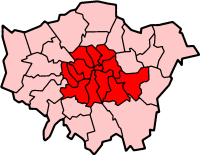Inner London
| Inner London | |
|---|---|
 Statutory definition |
|
 Statistical definition |
|
| Sovereign state | United Kingdom |
| Country | England |
| Region | London |
| Administrative area | Greater London |
| Area | |
| • Total | 123 sq mi (319 km2) |
| Population (2011) | |
| • Total | 3,231,901 |
| • Density | 26,000/sq mi (10,000/km2) |
| NUTS | UKI1 |
Inner London is the name for the group of London boroughs which form the interior part of Greater London and are surrounded by Outer London. With its origins in the Bills of mortality, it became fixed as an area for statistics in 1847 and was used as an area of local government from 1855 to 1965. It now has two common definitions. The first is the statutory definition delineated in the London Government Act 1963, coming into force on 1 April 1965, comprising twelve Inner London boroughs and almost identical to the County of London that was abolished at the same time. The second is the current definition used by the Office for National Statistics comprising eleven of the statutory Inner London boroughs and two of the statutory Outer London boroughs, and the City of London.
Inner London is smaller than Outer London both in terms of population and area, but the density of population is more than double that of Outer London. Inner London is officially the wealthiest area in Europe with the most expensive street in Europe, GDP per capita is more than €80,000 while the UK GDP per capita is around €27,000. Many of the world's wealthiest people live in Inner London, but there is also widespread poverty.Central London is located at the core of Inner London.
The area that is now Inner London was defined by the Registrar General as a collection of parishes called "London" and appeared in the 1851 Census. At the time the metropolitan area—commonly called the Metropolis—had its origins in the area of the Bills of mortality that had expanded from the tiny City of London into three surrounding counties over the previous several hundred years. The area become fixed in 1847 with the addition of Lewisham Poor Law Union and the parish of Hampstead. In 1855 the Registrar General area, with the addition of Penge, was used to define the district of the Metropolitan Board of Works. The Metropolis was also described as Inner London from the 1881 Census. In 1889 this area became the County of London. The area was adjusted in 1900 when Penge was transferred to Kent and South Hornsey was gained from Middlesex.
...
Wikipedia
